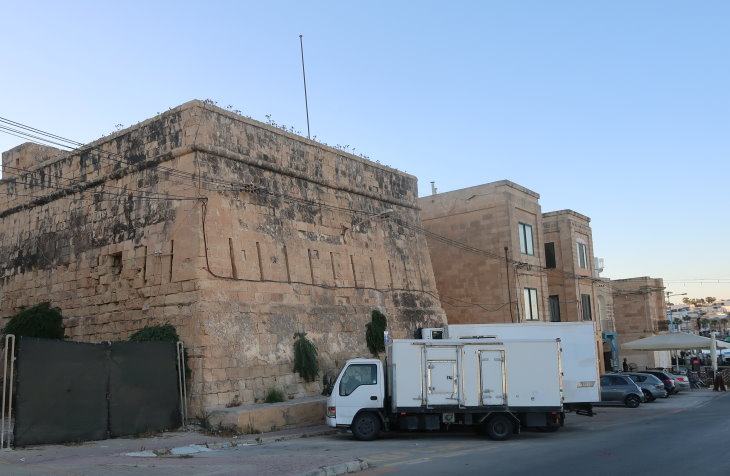 Marsaxlokk, once primarily the harbour for the famous colourful traditional boats, called luzzus, of the coastal fisheries in Malta is today even more of a tourist attraction than a major seafood conveyor in Malta's economy and society. It also hosts new types of vessels where tradition meets modernity. This island in the middle of the Mediterranean, close to Sicily and Tunisia, bears witness of thousands of years of mixing cultures, colonisation and creating a unique blend of architecture, food, arts and practices influenced by the locals, past invaders and today's visitors. Nice restaurants now line the harbour promenade. On Sunday, 11 September 2022 the traditional fish festival brought out masses of people to the fish, fruit, vegetable and souvenir stands of the market along the pier with traditional boats, small tourist transport vessels and other boats anchoring in sight.
Marsaxlokk, once primarily the harbour for the famous colourful traditional boats, called luzzus, of the coastal fisheries in Malta is today even more of a tourist attraction than a major seafood conveyor in Malta's economy and society. It also hosts new types of vessels where tradition meets modernity. This island in the middle of the Mediterranean, close to Sicily and Tunisia, bears witness of thousands of years of mixing cultures, colonisation and creating a unique blend of architecture, food, arts and practices influenced by the locals, past invaders and today's visitors. Nice restaurants now line the harbour promenade. On Sunday, 11 September 2022 the traditional fish festival brought out masses of people to the fish, fruit, vegetable and souvenir stands of the market along the pier with traditional boats, small tourist transport vessels and other boats anchoring in sight.
The visit was an opportunity not to miss for Mundus maris to delve a bit into the conditions of small-scale fishers in the changing seascape of Malta prior to the European leg of the 4th World Small-Scale Fisheries Congress convened from 12 to 14 September on the island. In the afternoon and evening, the fish market in Marsaxlokk gave way to information booths with lovingly maintained models of generations of luzzus, brochures about research results organised by the dynamic staff of the fisheries ministry, teaching aids by an NGO together with jaws to distinguish different shark species, more fish food and candy booths. A music stage attracted large crowds of all ages indulging in the folk songs and celebratory atmosphere.
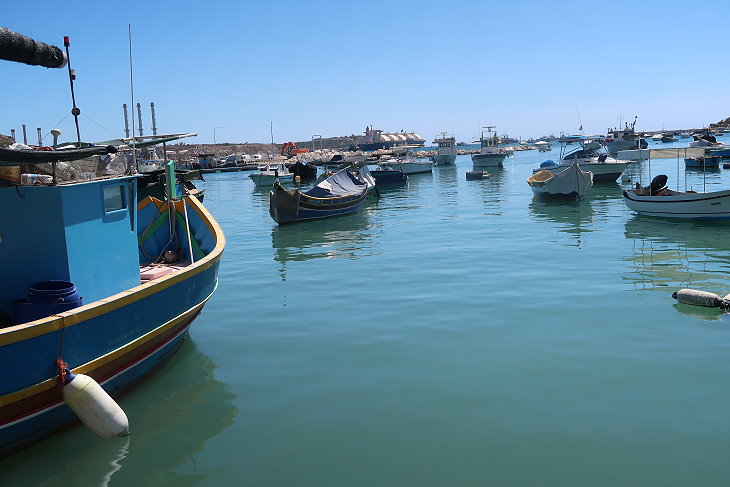
In 1952, Malta had its highest total catches right after the forced reduction of fishing during WWII as reconstructed by the Sea Around Us Initiative. European anchovy alone generated catches of more than 14,000 tons. The species has disappeared from the catches since 2018.1976 saw another peak in total catches of almost 16,000 tons, then extractions declining to less than 6,000 tons for the years between 1990 and 2012. Production picked up again somewhat, not the least driven by the beginning of tuna fattening in large marine cages. Recordings of catches have notably improved in the last few years though there is still much to be improved in the accuracy of the data. Staff shortages in the ministry do not help the data reliability. The steep increase in catches in 2018 was followed by an equally steep decline the following year.
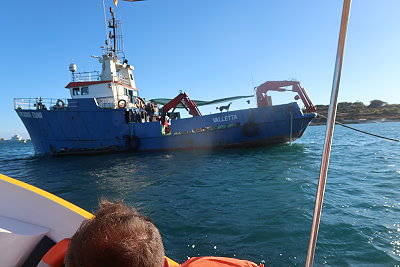 For the burgeoning tuna ranching, the bluefin tuna migrating along the coast are spotted during the spawning season and corraled between roughly April/May and July each year. Huge purse seines are operated by specialised vessels servicing the tuna fattening industry offshore. The transfer can take several weeks of towing them alive in the nets to their destination in the fattening cages so as to avoid damaging the valuable fish.
For the burgeoning tuna ranching, the bluefin tuna migrating along the coast are spotted during the spawning season and corraled between roughly April/May and July each year. Huge purse seines are operated by specialised vessels servicing the tuna fattening industry offshore. The transfer can take several weeks of towing them alive in the nets to their destination in the fattening cages so as to avoid damaging the valuable fish.
The transfer process to the only five tuna companies in Malta is normally monitored by the Fisheries Department of the Maltese Government, the European Fisheries Control Agency (EFCA, based in Vigo, Spain) and the International Commission for the Conservation of Atlantic Tunas (ICCAT) according to allowable quotas. Excess catches are supposed to be released alive to bring the populations back to more robust levels. The quantity of allowed juvenile tuna is then transferred into the cages.Two of the five tuna companies are foreign owned: the Ricardo Fuentes group of Spain, and the Toei Reefer Line of Japan.
 Originally small-scale fishers had caught Bluefin tuna with hook and line one fish at a time. In 2005 Malta issued the first quota for industrial purse seiners quickly leading to overfishing. When a regime of Individual Transferable Quota (ITQ) was introduced, it led to some resource recovery, but not all SSF could demonstrate they had traditionally fished tuna, because their catches had not been officially registered. Only 20% of previous full-time fishers were recognised as quota holders based on their recorded catches in the past. Newcomers - investors - to the industrial fisheries then bought ITQs from traditional fishers who could not all afford the licence fees. So the SSF have been largely pushed out of the previously lucrative business. Quite a number of fishers gave up or did not find replacements when reaching retirement age. The five heavy-weights in the ranching business now de facto control not only the quota, but also access to international markets. No new luzzus have been built in Marsaxlokk for some time now and quite a few went out of service over the years.
Originally small-scale fishers had caught Bluefin tuna with hook and line one fish at a time. In 2005 Malta issued the first quota for industrial purse seiners quickly leading to overfishing. When a regime of Individual Transferable Quota (ITQ) was introduced, it led to some resource recovery, but not all SSF could demonstrate they had traditionally fished tuna, because their catches had not been officially registered. Only 20% of previous full-time fishers were recognised as quota holders based on their recorded catches in the past. Newcomers - investors - to the industrial fisheries then bought ITQs from traditional fishers who could not all afford the licence fees. So the SSF have been largely pushed out of the previously lucrative business. Quite a number of fishers gave up or did not find replacements when reaching retirement age. The five heavy-weights in the ranching business now de facto control not only the quota, but also access to international markets. No new luzzus have been built in Marsaxlokk for some time now and quite a few went out of service over the years.
Provided with fish food caught earlier in the Mediterranean, now even further afield, the caged tuna need to attain the right size and consistency under the watchful eyes of the cage operators and their mostly Japanese buyers. The buyers from Japan appreciate Mediterranean Bluefin tuna particularly for the right balance between fat and meat and generally buy up some 70% of the annual production. During harvesting times the tuna get slaughtered and shock frozen to end up via the new Tokyo fish market in countless sashimi and sushi dishes in Japan and elsewhere.
Malta's legal tuna businesses generated more than €120 million in 2018. Malta is the biggest provider of fattened Bluefin tuna in the Mediterranean. Other major producers are Spain, Turkey, Croatia, Cyprus and Libya. Italy's attempts have apparently been halted. France never allowed tuna fattening. The Times of Malta reported in 2019 on Investigation Tarantelo into illegal Bluefin tuna transfers supposedly taking place between a ranch in Malta and Spain.
 So, what's the perspective of Maltese traditional fishers? Many already work for the ranchers during the tuna spawning season as deckhands. We saw some of the older generation reaching out to the public with lovely models of traditional luzzus during the festival in an attempt to keep the knowledge about the artisanal traditions alive.
So, what's the perspective of Maltese traditional fishers? Many already work for the ranchers during the tuna spawning season as deckhands. We saw some of the older generation reaching out to the public with lovely models of traditional luzzus during the festival in an attempt to keep the knowledge about the artisanal traditions alive.
Much of the future will depend on the handling of quota allocation and support of access to market for small-scale fishers in combination with rebuilding exhausted resources accessible to the artisans.
After all, the fishers don't want to be treated like museum pieces or only temporary tourist attraction. But because the boats have limited reach and already suffer from widespread overfishing, the discourse of establishing marine protected areas or at least closed seasons during spawning seasons of major target fish is highly problematic for their cash flow and ability to earn a living. Some mistrust arising in relation to earlier governments does not make dialogue and finding solutions for transition periods any easier. But without such dialogue it is much harder to imagine positive change. Will all parties be willing to listen to one another and build new trust as a basis for fair solutions?
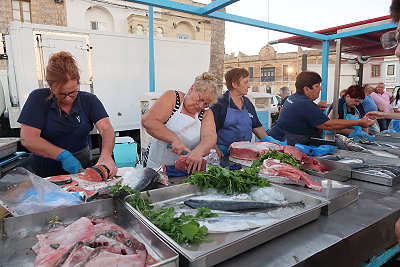 In the meantime, the show must go on. Market stands are happily selling tuna steaks next to still half frozen imported salmon and some whole lampuki on ice as here in the picture to the right. Most tourists won't anyway be able to distinguish very well between the different species. And the locals will remain choosy.
In the meantime, the show must go on. Market stands are happily selling tuna steaks next to still half frozen imported salmon and some whole lampuki on ice as here in the picture to the right. Most tourists won't anyway be able to distinguish very well between the different species. And the locals will remain choosy.
It's not an easy act to strike new balances between the cherished traditions and fitting in with the massive intrusion of foreign brands and global markets in fisheries and other parts of the economy. Can the Maltese keep some of their cultural heritage without denying access to types of innovation which would build on what makes Malta such a unique and interesting place but without destroying its soul?
Observing some of the clashes between tradition and modernity in Malta's contemporary fishing and aquaculture sectors, its ramifications with other economic and social activities can hardly be grasped in depth by a short stay. It is certainly not to suggest that small-scale fishers are only steeped in tradition and not creative and innovative as they search to secure their future.
Some of the broader picture throughout Europe was captured during the European leg of the 4th World Small-Scale Fisheries Congress hosted by the Ministry in charge of fisheries and the global research network 'Too Big To Ignore'. We report about that in a separate blog post.
Text and photos by Cornelia E Nauen.
 |
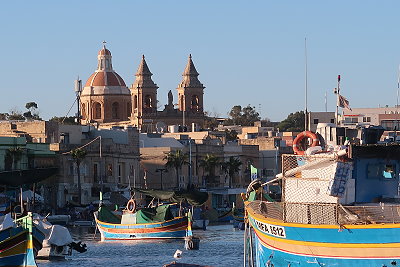 |
 |
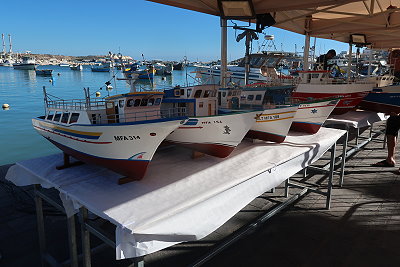 |
